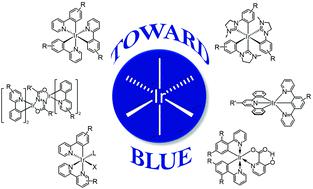当前位置:
X-MOL 学术
›
Inorg. Chem. Front.
›
论文详情
Our official English website, www.x-mol.net, welcomes your feedback! (Note: you will need to create a separate account there.)
Cyclometalated Ir(III) complexes towards blue-emissive dopant for organic light-emitting diodes: fundamentals of photophysics and designing strategies
Inorganic Chemistry Frontiers ( IF 7 ) Pub Date : 2020-05-07 , DOI: 10.1039/d0qi00001a Sunhee Lee 1, 2, 3, 4 , Won-Sik Han 1, 2, 3, 4
Inorganic Chemistry Frontiers ( IF 7 ) Pub Date : 2020-05-07 , DOI: 10.1039/d0qi00001a Sunhee Lee 1, 2, 3, 4 , Won-Sik Han 1, 2, 3, 4
Affiliation

|
The main difficulties hindering development of a deep-blue phosphorescent cyclometalated Ir(III) complex are insufficient colour purity, i.e., failure to achieve ideal Commission Internationale de L'Eclairage (CIE) coordinates of (0.14, 0.09), and insufficient emission efficiency and stability. The latter problem is due to the highly energetic and hot excited states of these complexes, which yield faster decomposition. Therefore, control of the excited-state properties of cyclometalated Ir(III) complexes through systematic chemical modification of the ligands is being extensively investigated, with the aim of developing efficient and stable blue phosphorescent materials. The most common strategies towards achievement of a blue phosphorescent cyclometalated Ir(III) complex involve (1) substitution of electron-withdrawing F atoms at the cyclometalating ligands that stabilise the HOMO orbitals and (2) use of a heteroleptic system with electron-rich ancillary ligands bearing a 5-membered ring heterocycle to increase the LUMO energy level. However, the C–F bonds on the cyclometalating ligands have been found to be inherently unstable during device operation; thus, other types of electron-withdrawing groups (e.g., the cyano, trifluoromethyl, and sulfonyl groups) have been applied. Along with phosphorescence colour tuning to blue, the influence of the ligand structure on the photoluminescence quantum yield (PLQY) is also being intensively investigated. Two major PLQY lowering mechanisms for blue emissive Ir(III) complexes have been identified: (1) the vibronic-coupled non-radiative decay process and (2) crossing from the emissive state to an upper non-emissive 3MC excited state. To enhance the PLQY, mechanism (1) can be suppressed by employing rigid ligand frameworks to restrict intramolecular motion, whereas mechanism (2) can be prevented by destabilising the 3MC state using strong σ donor ligands such as N-heterocyclic carbenes. This review summarises the fundamental photophysics of cyclometalated Ir(III) complexes and surveys design strategies for efficient blue phosphorescent Ir(III) complexes, to provide a guide for future research in this field.
中文翻译:

环金属化的Ir(III)配合物向有机发光二极管的蓝色发光掺杂剂:光物理原理和设计策略
阻碍深蓝色磷光环金属化Ir(III)配合物发展的主要困难是色纯度不足,即无法达到理想的国际照明委员会(CIE)坐标(0.14,0.09),以及发射效率和稳定性。后一个问题归因于这些配合物的高能态和热激发态,它们产生更快的分解。因此,控制环金属化Ir(III)广泛研究了通过对配体进行系统化学修饰的复合物,目的是开发高效稳定的蓝色磷光材料。实现蓝色磷光环金属化Ir(III)配合物的最常见策略涉及(1)在稳定HOMO轨道的环金属化配体上取代吸电子F原子,以及(2)使用具有富电子辅助性的杂配体系带有5元环杂环的配体可增加LUMO能级。然而,已经发现环金属化配体上的CF键在装置操作过程中固有地不稳定。因此,其他类型的吸电子基团(例如,氰基,三氟甲基和磺酰基)。随着磷光颜色调整为蓝色,配体结构对光致发光量子产率(PLQY)的影响也得到了深入研究。蓝色发射Ir(III)配合物的两个主要PLQY降低机制已被确定:(1)振动耦合的非辐射衰变过程和(2)从发射态过渡到较高的非发射3 MC激发态。为了增强PLQY,可以通过使用刚性配体框架限制分子内运动来抑制机制(1),而可以通过使3不稳定来防止机制(2)。MC状态使用强σ供体配体(例如N-杂环卡宾)。这篇综述总结了环金属化的Ir(III)配合物的基本光物理,并概述了有效的蓝色磷光Ir(III)配合物的设计策略,为该领域的未来研究提供了指导。
更新日期:2020-05-07
中文翻译:

环金属化的Ir(III)配合物向有机发光二极管的蓝色发光掺杂剂:光物理原理和设计策略
阻碍深蓝色磷光环金属化Ir(III)配合物发展的主要困难是色纯度不足,即无法达到理想的国际照明委员会(CIE)坐标(0.14,0.09),以及发射效率和稳定性。后一个问题归因于这些配合物的高能态和热激发态,它们产生更快的分解。因此,控制环金属化Ir(III)广泛研究了通过对配体进行系统化学修饰的复合物,目的是开发高效稳定的蓝色磷光材料。实现蓝色磷光环金属化Ir(III)配合物的最常见策略涉及(1)在稳定HOMO轨道的环金属化配体上取代吸电子F原子,以及(2)使用具有富电子辅助性的杂配体系带有5元环杂环的配体可增加LUMO能级。然而,已经发现环金属化配体上的CF键在装置操作过程中固有地不稳定。因此,其他类型的吸电子基团(例如,氰基,三氟甲基和磺酰基)。随着磷光颜色调整为蓝色,配体结构对光致发光量子产率(PLQY)的影响也得到了深入研究。蓝色发射Ir(III)配合物的两个主要PLQY降低机制已被确定:(1)振动耦合的非辐射衰变过程和(2)从发射态过渡到较高的非发射3 MC激发态。为了增强PLQY,可以通过使用刚性配体框架限制分子内运动来抑制机制(1),而可以通过使3不稳定来防止机制(2)。MC状态使用强σ供体配体(例如N-杂环卡宾)。这篇综述总结了环金属化的Ir(III)配合物的基本光物理,并概述了有效的蓝色磷光Ir(III)配合物的设计策略,为该领域的未来研究提供了指导。


























 京公网安备 11010802027423号
京公网安备 11010802027423号